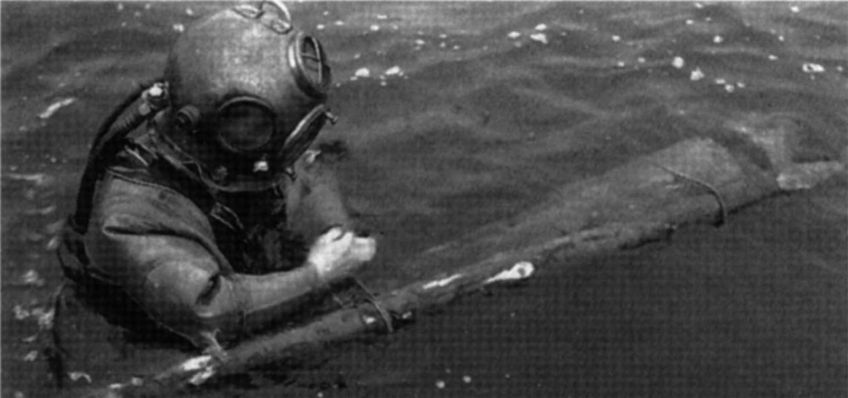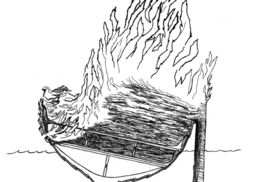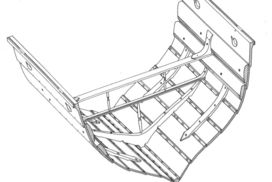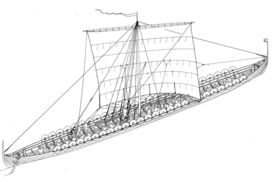
The longship from Haithabu Harbour
Haithabu, or Hedeby, which lies near Schleswig on the east coast of the Jutland Peninsula, was one of the Viking Age's most important trading places. Parts of a longship were found in Hedeby Harbour in 1953 during underwater investigations by divers. It was first possible to excavate the ship in 1979-80. This was done using the same methods as in the excavation of the Skuldelev ships, i.e. ramming a coffer dam around the wreck and empty the area of water. Though the purpose of the investigation was to excavate the Viking ship the coffer dam provided an opportunity to investigate the remains of jetties and the depositional layers accumulated on the seabed during the Viking Age.
Analyses of the sunken ship have revealed that it was unusually long and narrow. It measured about 30.9 m from stem to stern, while its greatest width was about 2.7 m and its depth was probably about 1.5 m. With a length more than 11 times its greatest width, this is the narrowest longship ever found. There was probably room for 30 pairs of oars in the ship, i.e. twice as many as the Ladby ship. A single centrally located mast carried a square sail.
The ship had been very skilfully built. The planks were made of radially-cloven oak wood and in some cases they were more than 10 m long. The technique used in their production requires the original wood to be twice as thick as the width of the finished plank. Therefore the plank widths of 25-37 cm mean that the construction of the ship required the felling of trees more than 1 m thick, over 10 m in length and with straight, knot-free trunks.
Corresponding examples of high quality craftsmanship can be seen elsewhere on the vessel. All the plank scarfs – the joints between the ends of the ship's planks – are shaped as elaborate tongue-scarfs. Along the edges of the planks and on the ship’s internal timbers run decorative mouldings, even in places where they are hidden when the ship is in use. An unusual feature, compared with other large longships, is that the iron rivets, which hold the hull together, are very small and are unusually closely spaced. This should probably also be perceived as an expression of the ship's particularly careful construction, where the use of a greater number of smaller rivets made it possible to disperse the loading on the ship more effectively. As a result, it was possible to use thinner and therefore lighter planks for the ship’s hull. The price for this was that a greater number of rivets had to be made and fitted.
The ribs in the vessel are placed close together, only 85 cm apart, and this was also the distance between the oarsmen's thwarts. Between the ribs there are slender half ribs, which reinforced the transition from bottom to side without presenting a hindrance to the oarsmen or occupying the limited space for cargo and ballast under the loose-fitting deck planks. The upper part of the hull was braced with stringers – robust plank-like reinforcements fastened to the inner surface of the ship’s planks. The ship does not differ in its basic construction from that of other large ships known from Late Viking times.
The ship's construction date has been identified with the aid of dendrochronology to c. AD 985. Its place of construction was probably somewhere in the Hedeby area or even at Hedeby itself. The high quality of the vessel, seen in the materials used, its design and execution leads us to believe that it must have belonged to a king, an earl or someone else from the very highest echelons of society. The ship met an abrupt end, apparently before it had reached the end of its useful life. Heavy charring in many places on the hull reveal that it apparently had been filled with combustible material and sent out in flames into Hedeby's harbour – perhaps to set light to other ships which lay there.
Danish text: Jan Bill
Translation: Gillian Fellows-Jensen
Archaeological findings of longships
Learn more about the longships we know today. Some were found in burial mounds, others in the Viking's harbours and others were recycled by the Vikings as part of defense systems of their main towns.
Below you can find links to read more about the longships.
» Ladby - the ship in the grave
» The longship from Haithabu Harbour



